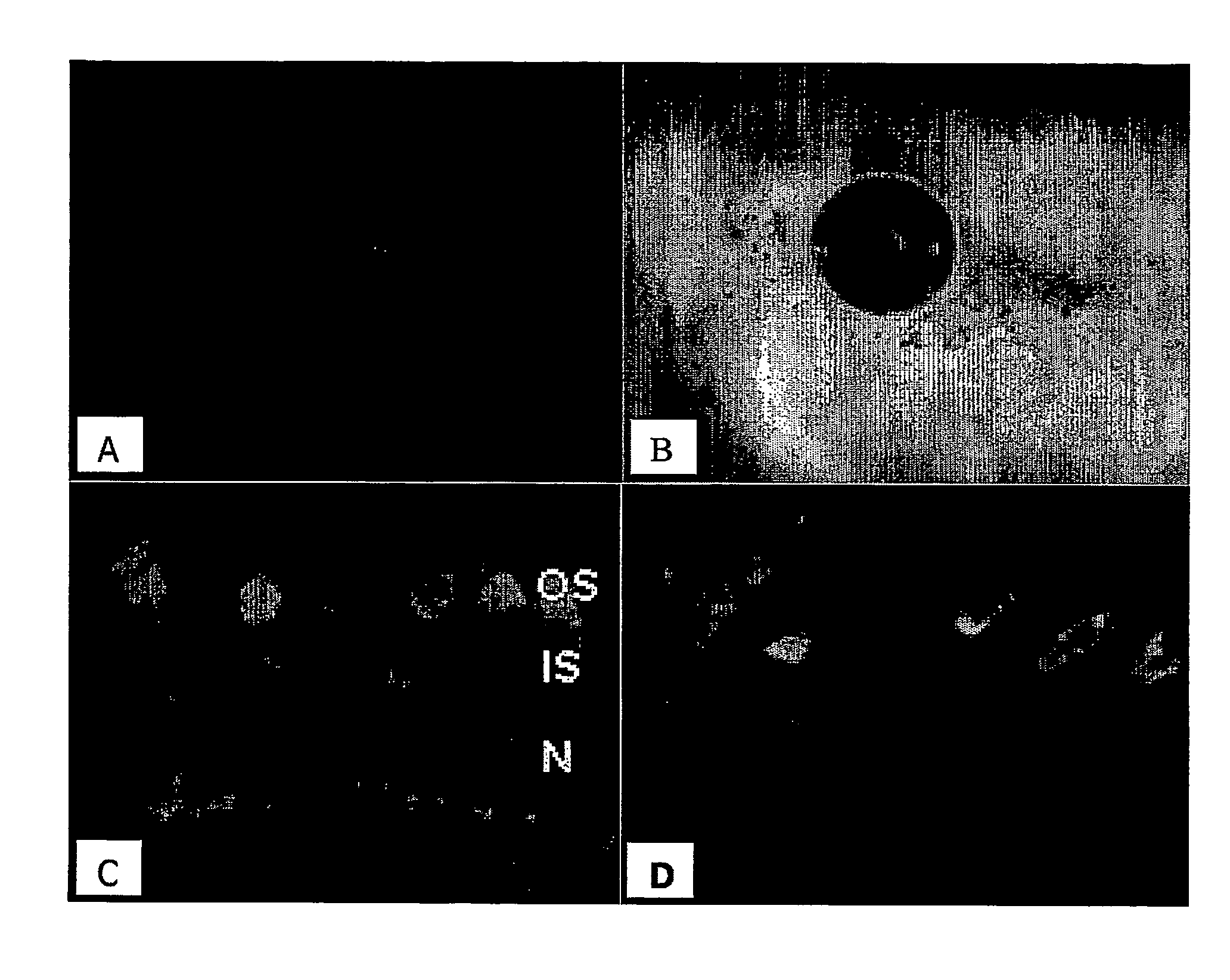Expression of polypeptides in rod outer segment membranes
a polypeptide and outer segment technology, applied in the field of protein structural biology and pharmaceutical design, can solve the problems of difficult to isolate in soluble form, affecting the stability of proteins, and unable to obtain atomic resolution structures of membrane proteins,
- Summary
- Abstract
- Description
- Claims
- Application Information
AI Technical Summary
Benefits of technology
Problems solved by technology
Method used
Image
Examples
example i
[0113] This example shows the construction of a gene targeting construct to replace mouse rhodopsin in the retina with a G-protein coupled receptor.
[0114] A genomic fragment containing all five exons of mouse rhodopsin and its regulatory elements is obtained by the method described in Humphries et al., Nature Genetics 15:216-219 (1997). Briefly, a rhodopsin cDNA probe is used to isolate a clone containing a 129Sv-derived mouse genomic fragment from a γ phage library. A restriction map of this fragment showing relevant restriction sites is shown in FIG. 1 (top). An 11 kb BamH1 fragment derived from the initial genomic fragment is subcloned into a pKO Scrambler V907 vector (Lexicon Genetics, Inc.) to generate the genomic clone shown in FIG. 1.
[0115] A transgenic cassette containing a G-protein coupled receptor cDNA tagged at its C-terminus with a 1D4 tag and a neomycin resistance gene flanked by two loxP sites is first constructed by standard molecular biology methods. Briefly, by P...
example ii
[0119] This example shows the construction of a gene targeting construct to replace mouse rhodopsin in the retina with the human cannabinoid receptor 2.
[0120] The human cannabinoid receptor 2 (CB2) cDNA (Genbank Accession No. X74328) is cloned from a human spleen cDNA library. The 9 amino acid 1D4 tag is added to the C-terminus of CB2 by PCR using the sense primer 5′-GCC GCC ACC ATG GAG GAA TGC TGG GTG AC (SEQ ID NO:8) and the anti-sense primer 5′-TTA GGC TGG AGC CAC CTG GCT GGT CTC CGT CTT GGA AGC GGT GGC AGA G (SEQ ID NO:9). The junction is sequenced to confirm that the CB2 / 1D4 fusion is in-frame. A neomycin resistance cassette (neo), with a phosphoglycerate kinase promoter and polyadenylation signal and flanked by loxP sites, is inserted downstream of the CB2 / 1D4 fusion. The targeting constructed is created by replacing the DNA segment between the Xho1 sites of the rhodopsin gene with the CB2-neo cassette, deleting 15 bp upstream of the translation start site and the first 111 c...
example iii
[0121] This example shows the introduction of a gene targeting construct into embryonic stem (ES) cells and the production of transgenic mice.
[0122] The gene targeting construct described in Example I or II is electroporated into 129Sv ES cells, and the ES cells are cultured in the presence of the neomycin analog G418. Correctly targeted ES clones, which have an altered rhodopsin locus as shown in FIG. 1 or 2, are resistant to G418. Incorrectly targeted clones are killed by expression of the DTα gene. DNA from G418 resistant clones is screened to confirm homologous recombination, by PCR analysis and Southern blotting.
[0123] The ES cells are transiently transfected with a Cre recombinase expression vector, such as a cytomegalovirus-Cre plasmid, and Cre-mediated excision of the neor gene at the flanking lox sites confirmed by sequence analysis of the PCR-amplified gene segment.
[0124] Correctly targeted ES cell clones with the neor gene excised are microinjected into C57BL / 6 blastoc...
PUM
| Property | Measurement | Unit |
|---|---|---|
| pH | aaaaa | aaaaa |
| pH | aaaaa | aaaaa |
| pH | aaaaa | aaaaa |
Abstract
Description
Claims
Application Information
 Login to View More
Login to View More - R&D
- Intellectual Property
- Life Sciences
- Materials
- Tech Scout
- Unparalleled Data Quality
- Higher Quality Content
- 60% Fewer Hallucinations
Browse by: Latest US Patents, China's latest patents, Technical Efficacy Thesaurus, Application Domain, Technology Topic, Popular Technical Reports.
© 2025 PatSnap. All rights reserved.Legal|Privacy policy|Modern Slavery Act Transparency Statement|Sitemap|About US| Contact US: help@patsnap.com



